|
|
 |
|
Calanoida ( Order ) |
|
|
|
Diaptomoidea ( Superfamily ) |
|
|
|
Candaciidae ( Family ) |
|
|
|
Candacia ( Genus ) |
|
|
| |
Candacia discaudata A. Scott, 1909 (F,M) | |
| | | | | | | Syn.: | Candacia bradyi : Carl, 1907 (p.9, part., figs.F) | | | | Ref.: | | | A. Scott, 1909 (p.157, figs.F,M); Sewell, 1914 a (p.230, Rem.); 1932 (p.335); Mori, 1937 (1964) (p.81, figs.F,M); Krishnaswamy, 1953 (p.129, fig.F); Chiba, 1956 (p.38, figs. Juv.M); Chiba & al., 1957 (p.310); 1957 a (p.11); Brodsky, 1962 c (p.140, figs.F); Grice, 1963 (p.175, Rem.); Kasturirangan, 1963 (p.44, 47, figs.F,M); Chen & Zhang, 1965 (p.92, figs.F,M); Kos, 1972 (Vol. I, figs F, M, Descr.); Lawson, 1973 a (p.487, Rem.); Marques, 1976 (p.994, fig.F); Lawson, 1977 (p.71, tab.2,3,4, fig.5); Greenwood, 1978 (p.9, figs.F); Marques, 1982 (p.763); Chihara & Murano, 1997 (p.753, Pl.73,76: F,M); Mulyadi, 1997 a (p.87, Redescr.F,M, figs.F,M); Vaupel Klein & Gassmann, 1998 (p.443, fig.M); Bradford-Grieve, 1999 b (p.168, figs.F,M, figs.182, 193); Conway & al., 2003 (p.1108, figs.F,M, Rem.); Mulyadi, 2004 (p.86, figs.F,M, Rem.); | 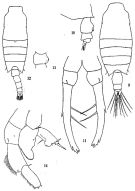 issued from: Q.-c Chen & S.-z. Zhang in Studia Marina Sinica, 1965, 7. [Pl.37, 9-14]. Female (from E China Sea): 9, habitus (dorsal); 10, urosome (lateral right side); 11, P5 (posterior). Male: 12, habitus (dorsal); 13, genital segment (dorsal); 14, P5 (posterior).
|
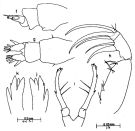 issued from : J.G. Greenwood in Proc. R. Soc. Qd, 1978, 89. [p.10, Fig.4]. Female (from Moreton Bay, E Australia): f, urosome (lateral right side); g, idem (dorsal); h, Mx2; i, P5; j-k, detail terminal portions of P5.
|
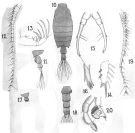 issued from : A. Scott in Siboga-Expedition, 1909, XIX a. [Plate XLVII, Figs.10-20]. Female (from Indonesia-Malaysia): 10, habitus (dorsal); 11, last thoracic and urosome (left side); 12, A1; 13, Mx2; 14, P3 (terminal spine on last segment of exopodite); 15, P5; 16, apex of last segment of P5 (enlarged). Male: 17, last thoracic and genital segments; 18, urosome (dorsal); 19, right A1; 20, P5.
|
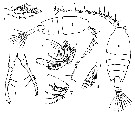 issued from : T. Mori in The Pelagic copepoda from the neighbouring waters of Japan, 1937 (1964). [Pl. 54, Figs.1-7]. Female: 1, P3; 3, P5; 5, P1; 6, habitus (dorsal). Male: 2, habitus (dorsal); 4, P5; 7, Mx2.
|
 issued from : N. Phukham in Species diversity of calanoid copepods in Thai waters, Andaman Sea (Master of Science, Univ. Bangkok). 2008. [p.145, Fig.19]. Female (from W Malay Peninsula): a, habitus (dorsal), A1 (at left side); b, urosome (dorsal); c, P5. Male: d, habitus (dorsal); e, urosome (dorsal); f, same (lateral, right side); g, P5. Body length after the drawings: F: = 1.943 mm; M = 1.543 mm.
|
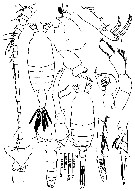 issued from : Mulyadi in Published by Res. Center Biol., Indonesia Inst. Sci. Bogor, 2004. [p.87, Fig.48]. Female (from 03°40'S, 128°10'E)): A, habitus (dorsal); B, forehead (lateral); C, angle of the 5th metasomal somite and urosome (lateral left side); D, A1; E, Mx2; F, P1; G, P5. Nota: The female is identifiable by ventral protrusion on urosomite2 and multiple apical teeth of the P5. Male: H, habitus (dorsal); I, angles of the 5th metasomal somite and urosome (dorsal); J, 5th metasomal somite and genital somite and urosomal somites 1 and 2 (lateral right side); K, 16th to 19th segments of right A1; L, P5 (anterior view). Nota: The male is identifiable by the single lateral swelling on genital somite and the form of the P5.
|
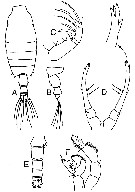 Issued from : J.M. Bradford-Grieve in NIWA Biodiversity Memoir 111, 1999. [p.168, Fig.118]. After Scott, 1909. Female (from SW Pacific): A, habitus (dorsal); B, urosome (lateral); C, Mx2; D, P5. Male (from SW Pacific): E, urosome (dorsal); F, P5. Female characteristics: - Posterior metasome points symmetrical, directed ventrally. Genital segment slightly asymmetrical viewed dorsally, without lateral projections, but with a short seta on each side; without any knob-like protrusions on the ventral side. Urosomal segment 2 considerably expanded in lateral view. - Anal segment distinctly asymmetrical. A1 23-segmented, extends to the middle of the genital segment. Mx2 basipod 2 with 2 spines, the proximal spine slightly longer and thicker than the distal spine P5 asymmetrical, apex of segment 3 produced into 3 closely set teeth, outer margin with 2 small spines, 2 moderately long setae on inner margin. Male characteristics: - Genital segment is asymmetrical, viewed dorsally the distal end right side is much inflated, viewed from right the inflated region bears a small tooth at each end. - Anal segment asymmetrical as in female. - Right A1 23-segmented, segments 2 and 3 fused, hinge between segments 18 and 19, segments 17 and 18 separate, segments 19 and 20 fused, outer margin of segments 16-18 are provided with rows of pigmented teeth as in C. bradyi. - Mx2 basipod 2 proximal spine considerably thicker than distal spine. - P5 left segments moderately long and broad, segment 4 with 2 small outer edge spines and 2 small apical spines; segment 3 of right leg has a large projection near distal end of inner margin.
|
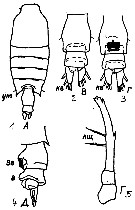 Issued from : M.C. Kos in Field guide for plankton. Zool Institute USSR Acad., Vol. I, 1972. After Brodsky, 1962. Female: 1, habitus (doesal); 2-3, abdomen (dorsal and ventral, respectively); 4, abdomen (lateral); 5, P5.
| | | | | Compl. Ref.: | | | Sewell, 1912 (p.353, 367); 1948 (p.418, 426); Ganapati & Shanthakumari, 1962 (p.9, 15); Stephen & Iyer, 1979 (p.228, tab.1, 3, 4, figs.3, 4); Sreekmaran Nair & al., 1981 (p.493, Fig.2); Dessier, 1983 (p.89, Tableau 1, Rem., %); Guangshan & Honglin, 1984 (p.118, tab.); Madhupratap & Haridas, 1986 (p.105, tab.1); Cervantes-Duarte & Hernandez-Trujillo, 1989 (tab.3); Othman & al., 1990 (p.561, 564, Table 1); Shih & Young, 1995 (p.69); Kotani & al., 1996 (tab.2); Noda & al., 1998 (p.55, Table 3, occurrence); Suarez-Morales & Gasca, 1998 a (p108); Lo & al., 2001 (1139, tab.I); Hsiao & al., 2004 (p.325, tab.1); Razai & al., 2004 (p.490, tab.2); Osore & al., 2004 (p.195); Lan & al., 2004 (p.332, tab.1); Lo & al., 2004 (p.89, tab.1); Zuo & al., 2006 (p.159, tab.1, abundance, fig.8: stations group); Dur & al., 2007 (p.197, Table IV); Fernandes, 2008 (p.465, Tabl. 2); Lan Y.C. & al., 2008 (p.61, Table 1, % vs stations); C.-Y. Lee & al., 2009 (p.151, Tab.2); W.-B. Chang & al., 2010 (p.735, Table 2, abundance); Shanthi & Ramanibai, 2011 (p.132, Table 1); Pillai H.U.K. & al., 2011 (p.239, Table 3, vertical distribution); Hsiao S.H. & al., 2011 (p.475, Appendix I); Maiphae & Sa-ardrit, 2011 (p.641, Table 2); Palomares-Garcia & al., 2013 (p.1009, Table I, abundance vs. environmental factors): in CalCOFI regional list (MDO, Nov. 2013; M. Ohman, pers. comm.); Tseng & al., 2013 (p.507, seasonal abundance); Jagadeesan & al., 2013 (p.27, Table 3, 5, 6, fig.11, seasonal abundance); | | | | NZ: | 7 | | |
|
Distribution map of Candacia discaudata by geographical zones
|
| | | | | | | | | 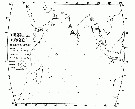 issued from : T.J. Lawson in Marine Biology, 1977, 43. [Fig.5, p.81]. issued from : T.J. Lawson in Marine Biology, 1977, 43. [Fig.5, p.81].
Distribution map for the Indian Ocean. |
 issued from : Mulyadi in Treubia, 1997, 31 (2). [p.109, Fig.16]. issued from : Mulyadi in Treubia, 1997, 31 (2). [p.109, Fig.16].
Distribution of Candaciidae in Indonesian waters. 5: C. discaudata.
|
| | | | Loc: | | | Kennya, Rodrigues Is., Seychelles, India (off Cochin, Lawson's Bay, Madras, G. of Mannar), E India, Bay of Bengal, Andaman Sea (Batten Island), Straits of Malacca, Thailand, Indonesia-Malaysia, Java (Cilacap Bay, ,off Sirabaya) Lombok Sea, Flores Sea, China Seas (East China Sea, South China Sea), Taiwan (S, SW, E, NW, NE), Japan, Kuchinoerabu Is., Pacif. (E- W equatorial), Australia (G. of Carpentaria, Great Barrier, Moreton Bay), W Pacif., Bikini Is., W Baja California, G. of California (rare) | | | | N: | 49 (Indian: 18; Indo-Malaysia: 6; Pacif.: 25) | | | | Lg.: | | | (5) F: 1,94; M: 1,8; (34) F: 1,82-1,6; M: 1,82-1,52; (150) F: 1,7; (290) F: 1,68; M: 1,6; (334) F: 1,94; M: 1,8; (778) F: 1,7-1,6; M: 1,6-1,54; (795) F: 1,9; (991) F: 1,55-1,94; M: 1,48-1,8; (1122) F: 1,65; M: 1,6; (1260) F: 1,7-1,8; M: 1,7; {F: 1,55-1,94; M: 1,48-1,82}
The mean female size is 1.752 mm (n = 12; SD = 0.1479), the mean male size is 1.656 mm (n = 10; SD = 0.1339). The size ratio (male : female) is 0.95 (n = 7; SD = 0.0192). | | | | Rem.: | This species is characteristic for West Indo-Pacific forms.
For Sewell, 1912 (p.367) this species was very abundant in the Bay of Bengal.
According to Grice (1963, p.175), except for Chiba's (1956) statement that species is typical of cold currents in the Japan area, this species is known mostly from tropical areas especially the Indo-Pacific region.
See in DVP Conway & al., 2003 (version 1) | | | Last update : 09/12/2020 | |
|
|
 Any use of this site for a publication will be mentioned with the following reference : Any use of this site for a publication will be mentioned with the following reference :
Razouls C., Desreumaux N., Kouwenberg J. and de Bovée F., 2005-2025. - Biodiversity of Marine Planktonic Copepods (morphology, geographical distribution and biological data). Sorbonne University, CNRS. Available at http://copepodes.obs-banyuls.fr/en [Accessed December 26, 2025] © copyright 2005-2025 Sorbonne University, CNRS
|
|
 |
 |













